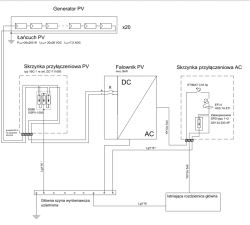Hello, where should the phase wires from the inverter output be connected? Is it before the main switch in the switchgear or after the switch?

Czy wolisz polską wersję strony elektroda?
Nie, dziękuję Przekieruj mnie tamandrzejamp wrote:Does this mean full freedom just behind the counter?

andrzejamp wrote:The inverter on the AC side is treated as a regular "permanently" connected device. It is no different from, for example, a boiler. According to the technical documentation, it can be additionally protected, e.g. by RCD. But on a 30mA RCD, it will trip it 90%. Surge arresters should be provided on the DC side. Switches, fuses depending on the design and requirements, conditions.And within the home switchboard itself, where should the phase wires from the photovoltaics be connected? Are there any established standards or guidelines for this?
andrzejamp wrote:If the photovoltaic installation is treated as a permanent receiver, can it be connected behind the main switch, e.g. to a distribution block?
andrzejamp wrote:Buddy, but you need to secure the line to the inverter somehow... you can't ignore it.If the photovoltaic installation is treated as a permanent receiver, can it be connected behind the main switch, e.g. to a distribution block?
andrzejamp wrote:I'm sorry, but you're asking something that has already been answered.In the diagram I attached above, the protections are marked.
andrzejamp wrote:No, it doesn't, but it should be there! It should, because it's supposed to be a new table that is supposed to take into account the entire installation. So the PV part as well.Which does not mean that the contents of the AC box will not be in the new switchgear.
andrzejamp wrote:Is it before the main switch in the switchgear or after the switch?
andrzejamp wrote:...can it be connected downstream of the main switch, e.g. to a distribution block?
andrzejamp wrote:One false - nonsensical.In the discussion there were two answers that behind the meter and that PV installations should be treated like any fixed receiver.
andrzejamp wrote:But I don't think calling the inverter a receiver or a source or both at the same time does not change the connection method in this case?
andrzejamp wrote:First of all, it's an inverter - not an inverter.If the inverter and gives and draws energy from the power line then what is it.
andrzejamp wrote:There is no way to write how to connect.or he will write how he connects the inverter to the power line treating it as a generator.
andrzejamp wrote:And what is all the electronics in the inverter powered from?
